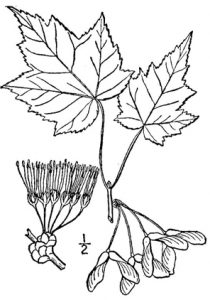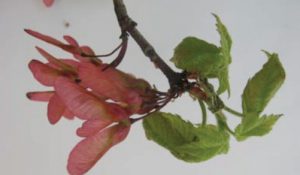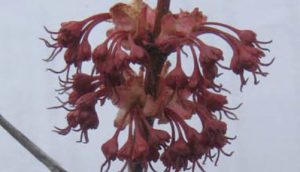Red Maple (Acer rubrum) Fact Sheet

Red Maple is a deciduous tree that can be 50 to 60 feet tall at maturity. It is wide ranging, and native throughout the eastern half of the United States. Red maple can be used for syrup production. However, it tends to bud and flower very early in the season, which has a negative effect on the sap, making the syrup season for the red maple very short.
Leaves: Maple trees have palmately lobed leaves, which means their leaves resemble the shape of a hand with five lobes that extend in a fingerlike fashion from a central point, similar to palm of your hand. It is easy to confuse red maple with sugar maple. To distinguish them, look at the teeth on the leaf edges. Red maple leaves are more toothed, while the lobes on sugar maples have smoother edges. Red maple leaves are green on the top and a light greenish white on the underside, and turn brilliant red in autumn. The leaf stalk and twigs also have a reddish color.
Flowers: Small, hanging clusters of bright red flowers appear in spring before the leaves. Two red maple trees may look different from each other during the flowering period. Red Maples can produce all male flowers, all female flowers, or some of both. Male flowers have long stamens that extend beyond the petal and are covered in yellow pollen at the tips. In the female flower it is the stigma that extends past the petals, ready to catch pollen. It is the female flower that produces the fruit.
|
|
Fruit: Maple trees produce double samaras (winged seeds), but you may know them as “spinners” or “helicopters” due to their characteristic descent to the ground. Red maple samaras are red, in contrast to those of sugar maple, which are green in spring. These samaras disperse in spring before the leaves are fully developed (sugar maple samaras hang on until the fall).

Bark: Young red maples have smooth, light gray bark. Bark on older trees is often broken into plates.
Tips on Observing Maples: The most challenging aspect of observing the maples is that the leaves and flowers can be high up in the tree. Take field glasses (binoculars) out with you so you can see the flowers, which are beautiful dark red, with yellow stamens (sugar maple flowers are green). Pollen release is easy to tell—look on the ground for yellow powder. Some people may not think of maple samaras as fruits, but they are the fruits of maple trees. To a botanist, anything that contains seeds is a fruit, but to others those may be just “spinners.” Remember, those are the fruits!
Distribution
Sources / For More Information:
USDA, NRCS. 2012. The PLANTS Database (http://plants.usda.gov, 20 May 2012). National Plant Data Team, Greensboro, NC 27401-‐4901 USA.
USA Phenology Network – Observing Plants and Animals, http://www.usanpn.org/Acer_Rubrum
Native Plant Database, Lady Bird Johnson Wildflower Center, University of Texas at Austin, http://www.wildflower.org/plants/result.php?id_plant=ACRU
The Sex Life of the Red Maple – Richard Primack, Boston University and Arnold Arboretum http://arnoldia.arboretum.harvard.edu/pdf/articles/2004-63-1-the-sex-life-of-the-red-maple.pdf


